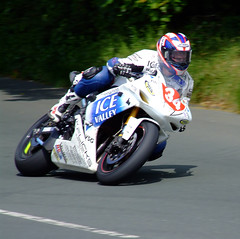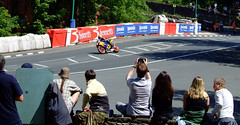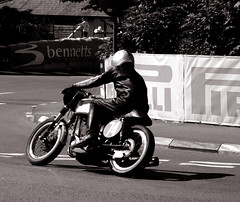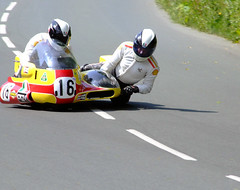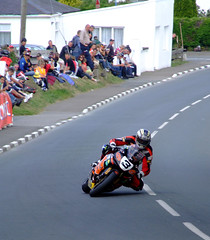Rumours
There appear to be an awful lot of stories doing the rounds in the F1 paddock at the moment. Whisperings that leading teams are unhappy with one or more of their drivers, and, come to that, rumours of drivers decidedly unhappy with their teams.
Of course, in an environment as intrinsically competitive as Formula 1, when the results aren't coming, it is natural that the leading players will be desperately seeking to understand why this should be. Inevitably, some will wonder if a key player who is a weak link in the chain - a chief designer, a driver or a team manager who isn't pulling his weight. It is human nature, too that the last person that most F1 people will think of as the weak link is himself. You can be sure that while the rest of the world might think that Ralf Schumacher isn't doing a very good job at Toyota, or that Honda is being terribly managed, Ralf and Nick Fry will be convinced that the blame lies with others.
So, what are the stories doing the rounds? Ralf Schumacher seems as good a place to start as any, as an awful lot of other questions might hang on his future. Schumacher, who is widely rumoured to the second-highest paid driver on the F1 grid, has not had the best of seasons at Toyota. He has scored just 2 points all year, compared to his team mate Jarno Trulli's 7. More importantly, he has looked off the pace when compared to his team mate all year. He was outqualified by the two Spykers at Monaco, he made a silly mistake which put him out on the first lap at Indianapolis. Come to that, even in the races where he did score points - Australia and Canada - his performances were hardly outstanding. In Australia he threw away 7th place, allowing Nico Rosberg past him on a track where passing is normally all but impossible. In Canada, he may have made the points, but on a day with such a high attrition rate, his team might reasonably have hoped for better than 8th place.
Toyota's problem is this: Given that they're paying for him anyway, and given the extreme difficulties in enforcing performance-clauses, is there any point in getting rid of Schumacher Jr before his contract comes up at the end of the season? He may not appear to be doing a very good job, but it has to be said that the Toyota does not appear to be an especially good car. It is not clear, either, who would take his place. The team could draft in test driver Franck Montagny, who would probably be competent, but he wasn't so good that Renault thought him worth keeping - and that despite his nationality... And if not Montagny, then it is unclear quite who they would go with. Kazuki Nakajima has links with the team, but surely lacks the experience necessary to do any better than Schumacher - besides which, he has looked unexceptional in absolute terms in GP2, and wasn't as quick as, for example, Paul Di Resta in F3 last year.
So, chances are, Ralf Schumacher will keep his drive until the end of the year, but that this might well be his final season in the sport. Next question. Who might replace him in 2008? If some of the wilder rumours are to be believed, the answer to this question could be.....Kimi Raikkonen
At first glance, this might appear to be rather far-fetched. Haven't Ferrari paid him some unimaginable sum to be his lead driver until the end of 2008? On closer inspection, though, perhaps it is possible. Its hard to avoid the conclusion that the Raikkonen-Ferrari marriage has got off to a rather rocky start this tear. Ferrari have been decisively outpaced by Mclaren in recent races and the question must be there in the back of Jean Todt's mind - Is it the drivers?
Felipe Massa had, on balance, been quicker than Kimi Raikkonen this year, despite the pre-season assumption on the part of most observers that he was the de facto Number 2 at Maranello. This has been seen by some as a sign of remarkably improved form from the previously rather mercurial Brazilian, but what if it isn't so much that Massa is quicker than we thought he would be, as that Raikkonen is slower?
If that were so, then it would suggest that, with a driver of the calibre of an Alonso or a Hamilton, Ferrari might be able to mix it with Mclaren without having to find improvements in the car. The trouble is, though, if the team believe that neither Massa nor Raikkonen are their best options, who else on the grid might do a better job?
If paddock gossip is anything to go by, it would seem that the Ferrari management have alighted upon the promising Williams driver (and the other GP2 champion) Nico Rosberg. Working on the assumption that Alex Wurz hasn't forgotten to drive in the years since he was last a full time racing driver, it does rather appear that Rosberg Jr is getting the Williams much further up the grid than it really deserves to be. Of course, the same thing appeared to be true of Mark Webber at Jaguar, and he's never really looked quite so quick since, but if Ferrari become convinced that Kimi Raikkonen is not the answer to the conundrum of replacing Michael Schumacher, they may as well try someone else.
So if Rosberg goes to Ferrari, Kimi Raikkonen would be in line for being shuffled off to Toyota (if retirement doesn't seem the more appealing option) and Williams, who would struggle somewhat with meeting Raikkonen's fees, might well go chasing Adrian Sutil.
But what if that's not what happens. What if Ferrari decide that the best way to take on Mclaren's seemingly invincible driver line-up is to snatch one of them. Mclaren would probably be very reluctant to let either of them go - the biggest advantage of having the two quickest drivers on the grid tied into long-term contracts is that the best on offer to any putative rival is the third fastest driver on the grid. Ron Dennis will remember well that, whatever his other problems at the time, when he had Senna and Prost in the late eighties, the other teams never posed much of a threat.
The problem is that the drivers themselves might not see it that way. Both Fernando Alonso and Lewis Hamilton might feel that they are drivers of the kind of stature that deserves undisputed no.1 status. They can't both have that at Mclaren, so if a vacancy were to open up at Ferrari at the end of the season, would Ron really be able to keep hold of both his young charges?
There's one final thought, which I haven't heard aired this season, but which I can't write off as entirely fanciful. Remember what Alonso said at the end of last season, after he had won his second world title? He said that "3 world championships is a good number. It's what Senna got, it's what Piquet got, it's what Lauda got. I don't want to be a racing driver forever." Fernando has never enjoyed the fame and attention that has come with being a double F1 world championship and neither does he appear to be revelling in the challenge posed by his rookie team mate this year. He must know, too, that given time, Hamilton is only likely to get better. Could it be that, if he were to win the title this year, he would simply walk away from the sport, job done, still only in his mid-twenties? What would that do to the driver market?
Of course, in an environment as intrinsically competitive as Formula 1, when the results aren't coming, it is natural that the leading players will be desperately seeking to understand why this should be. Inevitably, some will wonder if a key player who is a weak link in the chain - a chief designer, a driver or a team manager who isn't pulling his weight. It is human nature, too that the last person that most F1 people will think of as the weak link is himself. You can be sure that while the rest of the world might think that Ralf Schumacher isn't doing a very good job at Toyota, or that Honda is being terribly managed, Ralf and Nick Fry will be convinced that the blame lies with others.
So, what are the stories doing the rounds? Ralf Schumacher seems as good a place to start as any, as an awful lot of other questions might hang on his future. Schumacher, who is widely rumoured to the second-highest paid driver on the F1 grid, has not had the best of seasons at Toyota. He has scored just 2 points all year, compared to his team mate Jarno Trulli's 7. More importantly, he has looked off the pace when compared to his team mate all year. He was outqualified by the two Spykers at Monaco, he made a silly mistake which put him out on the first lap at Indianapolis. Come to that, even in the races where he did score points - Australia and Canada - his performances were hardly outstanding. In Australia he threw away 7th place, allowing Nico Rosberg past him on a track where passing is normally all but impossible. In Canada, he may have made the points, but on a day with such a high attrition rate, his team might reasonably have hoped for better than 8th place.
Toyota's problem is this: Given that they're paying for him anyway, and given the extreme difficulties in enforcing performance-clauses, is there any point in getting rid of Schumacher Jr before his contract comes up at the end of the season? He may not appear to be doing a very good job, but it has to be said that the Toyota does not appear to be an especially good car. It is not clear, either, who would take his place. The team could draft in test driver Franck Montagny, who would probably be competent, but he wasn't so good that Renault thought him worth keeping - and that despite his nationality... And if not Montagny, then it is unclear quite who they would go with. Kazuki Nakajima has links with the team, but surely lacks the experience necessary to do any better than Schumacher - besides which, he has looked unexceptional in absolute terms in GP2, and wasn't as quick as, for example, Paul Di Resta in F3 last year.
So, chances are, Ralf Schumacher will keep his drive until the end of the year, but that this might well be his final season in the sport. Next question. Who might replace him in 2008? If some of the wilder rumours are to be believed, the answer to this question could be.....Kimi Raikkonen
At first glance, this might appear to be rather far-fetched. Haven't Ferrari paid him some unimaginable sum to be his lead driver until the end of 2008? On closer inspection, though, perhaps it is possible. Its hard to avoid the conclusion that the Raikkonen-Ferrari marriage has got off to a rather rocky start this tear. Ferrari have been decisively outpaced by Mclaren in recent races and the question must be there in the back of Jean Todt's mind - Is it the drivers?
Felipe Massa had, on balance, been quicker than Kimi Raikkonen this year, despite the pre-season assumption on the part of most observers that he was the de facto Number 2 at Maranello. This has been seen by some as a sign of remarkably improved form from the previously rather mercurial Brazilian, but what if it isn't so much that Massa is quicker than we thought he would be, as that Raikkonen is slower?
If that were so, then it would suggest that, with a driver of the calibre of an Alonso or a Hamilton, Ferrari might be able to mix it with Mclaren without having to find improvements in the car. The trouble is, though, if the team believe that neither Massa nor Raikkonen are their best options, who else on the grid might do a better job?
If paddock gossip is anything to go by, it would seem that the Ferrari management have alighted upon the promising Williams driver (and the other GP2 champion) Nico Rosberg. Working on the assumption that Alex Wurz hasn't forgotten to drive in the years since he was last a full time racing driver, it does rather appear that Rosberg Jr is getting the Williams much further up the grid than it really deserves to be. Of course, the same thing appeared to be true of Mark Webber at Jaguar, and he's never really looked quite so quick since, but if Ferrari become convinced that Kimi Raikkonen is not the answer to the conundrum of replacing Michael Schumacher, they may as well try someone else.
So if Rosberg goes to Ferrari, Kimi Raikkonen would be in line for being shuffled off to Toyota (if retirement doesn't seem the more appealing option) and Williams, who would struggle somewhat with meeting Raikkonen's fees, might well go chasing Adrian Sutil.
But what if that's not what happens. What if Ferrari decide that the best way to take on Mclaren's seemingly invincible driver line-up is to snatch one of them. Mclaren would probably be very reluctant to let either of them go - the biggest advantage of having the two quickest drivers on the grid tied into long-term contracts is that the best on offer to any putative rival is the third fastest driver on the grid. Ron Dennis will remember well that, whatever his other problems at the time, when he had Senna and Prost in the late eighties, the other teams never posed much of a threat.
The problem is that the drivers themselves might not see it that way. Both Fernando Alonso and Lewis Hamilton might feel that they are drivers of the kind of stature that deserves undisputed no.1 status. They can't both have that at Mclaren, so if a vacancy were to open up at Ferrari at the end of the season, would Ron really be able to keep hold of both his young charges?
There's one final thought, which I haven't heard aired this season, but which I can't write off as entirely fanciful. Remember what Alonso said at the end of last season, after he had won his second world title? He said that "3 world championships is a good number. It's what Senna got, it's what Piquet got, it's what Lauda got. I don't want to be a racing driver forever." Fernando has never enjoyed the fame and attention that has come with being a double F1 world championship and neither does he appear to be revelling in the challenge posed by his rookie team mate this year. He must know, too, that given time, Hamilton is only likely to get better. Could it be that, if he were to win the title this year, he would simply walk away from the sport, job done, still only in his mid-twenties? What would that do to the driver market?
Labels: ferrari, formula 1, kimi raikkonen, ralf schumacher, toyota, williams

